Acer 5000 User Manual
Aspire 3000/5000 Series
User's Guide
Copyright © 2005. Acer Incorporated.
All Rights Reserved.
Aspire 3000/5000 Series User's Guide
Original Issue: March 2005
Changes may be made periodically to the information in this publication without obligation to notify any person of such revisions or changes. Such changes will be incorporated in new editions of this manual or supplementary documents and publications. This company makes no representations or warranties, either expressed or implied, with respect to the contents hereof and specifically disclaims the implied warranties of merchantability or fitness for a particular purpose.
Record the model number, serial number, purchase date, and place of purchase information in the space provided below. The serial number and model number are recorded on the label affixed to your computer. All correspondence concerning your unit should include the serial number, model number, and purchase information.
No part of this publication may be reproduced, stored in a retrieval system, or transmitted, in any form or by any means, electronically, mechanically, by photocopy, recording, or otherwise, without the prior written permission of Acer Incorporated.
Aspire 3000/5000 Series Notebook Computer
Model Number: __________________________________
Serial Number: ___________________________________
Purchase Date: ___________________________________
Place of Purchase: ________________________________
Acer and the Acer logo are registered trademarks of Acer Incorporated. Other companies' product names or trademarks are used herein for identification purposes only and belong to their respective companies.

iii
First things first
We would like to thank you for making the Aspire series of notebook computers your choice for your mobile computing needs.
Your guides
To help you use your Aspire, we have designed a set of guides:
First off, the Just for starters... poster helps you get started with setting up your computer.
The printed User's Guide introduces you to the basic features and functions of your new computer. For more on how your computer can help you to be more productive, please refer to the AcerSystem User's Guide. This guide contains detailed information on such subjects as system utilities, data recovery, expansion options, and troubleshooting. In addition it contains warranty information and the general regulations and safety notices for your notebook. It is available in Portable Document Format (PDF) and comes preloaded on your notebook. Follow these steps to access it:
1Click on Start, All Programs, AcerSystem.
2Click on AcerSystem User's Guide.
Note: Viewing the file requires Adobe Acrobat Reader. If Adobe Acrobat Reader is not installed on your computer, clicking on AcerSystem User's Guide will run the Acrobat Reader setup program first. Follow the instructions on the screen to complete the installation. For instructions on how to use Adobe Acrobat Reader, access the Help and Support menu.
Basic care and tips for using your computer
Turning your computer on and off
To turn on the computer, simply press and release the power button below the LCD screen beside the launch keys. See "Front view" on page 1 for the location of the power button.
To turn the power off, do any of the following:
•Use the Windows shutdown command
Click on Start, Turn Off Computer; then click on Turn Off.
•Use the power button

iv
Note: You can also use the power button to perform power management functions. See "Moving around" on page 43 of the AcerSystem User's Guide.
•Use the customized functions for power management
You can also shut down the computer by closing the display cover, or by pressing the sleep hot key <Fn> + <F4>. See "Moving around" on page 43 of the AcerSystem User's Guide.
Note: If you cannot power off the computer normally, press and hold the power button for more than four seconds to shut down the computer. If you turn off the computer and want to turn it on again, wait at least two seconds before powering up.
Taking care of your computer
Your computer will serve you well if you take care of it.
•Do not expose the computer to direct sunlight. Do not place it near sources of heat, such as a radiator.
•Do not expose the computer to temperatures below 0 ºC (32 ºF) or above 50 ºC (122 ºF).
•Do not subject the computer to magnetic fields.
•Do not expose the computer to rain or moisture.
•Do not spill water or any liquid on the computer.
•Do not subject the computer to heavy shock or vibration.
•Do not expose the computer to dust and dirt.
•Never place objects on top of the computer.
•Do not slam the computer display when you close it.
•Never place the computer on uneven surfaces.
Taking care of your AC adaptor
Here are some ways to take care of your AC adaptor:
•Do not connect the adaptor to any other device.
•Do not step on the power cord or place heavy objects on top of it. Carefully route the power cord and any cables away from foot traffic.
•When unplugging the power cord, do not pull on the cord itself but pull on the plug.
•The total ampere ratings of the equipment plugged in should not exceed the ampere rating of the cord if you are using an extension cord. Also, the total current rating of all equipment plugged into a single wall outlet should not exceed the fuse rating.
v
Taking care of your battery pack
Here are some ways to take care of your battery pack:
•Use only batteries of the same kind as replacements. Turn the power off before removing or replacing batteries.
•Do not tamper with batteries. Keep them away from children.
•Dispose of used batteries according to local regulations. Recycle if at all possible.
Cleaning and servicing
When cleaning the computer, follow these steps:
1Power off the computer and remove the battery pack.
2Disconnect the AC adaptor.
3Use a soft, moist cloth. Do not use liquid or aerosol cleaners.
If either of the following occurs:
•the computer has been dropped or the body has been damaged.
•the computer does not operate normally.
Please refer to "Frequently asked questions" on page 23.
Caution
Changes or modifications not expressly approved by the manufacturer could void the user's authority, which is granted by the Federal Communications Commission, to operate this computer.
Operation conditions
This device complies with Part 15 of the FCC Rules. Operation is subject to the following two conditions: (1) this device may not cause harmful interference, and (2) this device must accept any interference received, including interference that may cause undesired operation.
Users are requested to follow the RF safety instructions on wireless option devices that are included in the user's manual of each RF option device.
An improper installation or unauthorized use may cause harmful interference to radio communications. Also any tampering of the internal antenna will void the FCC certification and your warranty.
To prevent radio interference to the licensed service, this device is intended to be operated indoors and installation outdoors is subject to licensing.
For more information about our products, services, and support information, please visit our website: http://global.acer.com.
Contents
First things first |
iii |
Your guides |
iii |
Basic care and tips for using your computer |
iii |
Turning your computer on and off |
iii |
Taking care of your computer |
iv |
Taking care of your AC adaptor |
iv |
Taking care of your battery pack |
v |
Cleaning and servicing |
v |
An Aspire tour |
1 |
Front view |
1 |
Closed front view |
2 |
Left view |
3 |
Right view |
3 |
Rear view |
4 |
Base view |
5 |
Specifications |
6 |
Indicators |
9 |
Launch keys |
10 |
Touchpad |
11 |
Touchpad basics |
11 |
Using the keyboard |
13 |
Lock keys and embedded numeric keypad |
13 |
Windows keys |
14 |
Hot keys |
14 |
Special keys |
16 |
Ejecting the optical (CD or DVD) drive tray |
17 |
Using a computer security lock |
17 |
Audio |
18 |
Adjusting the volume |
18 |
Using the system utilities |
19 |
Acer eManager |
19 |
Acer GridVista (dual-display compatible) |
20 |
Launch Manager |
22 |
Frequently asked questions |
23 |
Requesting service |
27 |
International Travelers Warranty (ITW) |
27 |
Before you call |
27 |
Arcade (for selected models) |
29 |
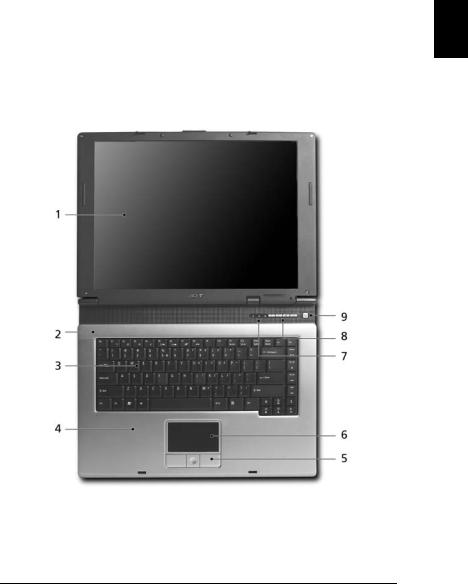
1
An Aspire tour
After setting up your computer as illustrated in the Just for Starters... poster, let us show you around your new Aspire computer.
Front view
English
# |
Item |
Description |
1 |
Display screen |
Also called Liquid-Crystal Display (LCD), displays computer |
|
|
output. |
|
|
|
2 |
Microphone |
Internal microphone for sound recording. |
|
|
|
3 |
Keyboard |
For entering data into your computer. |
4 |
Palmrest |
Comfortable support area for your hands when you use the |
|
|
computer. |
|
|
|
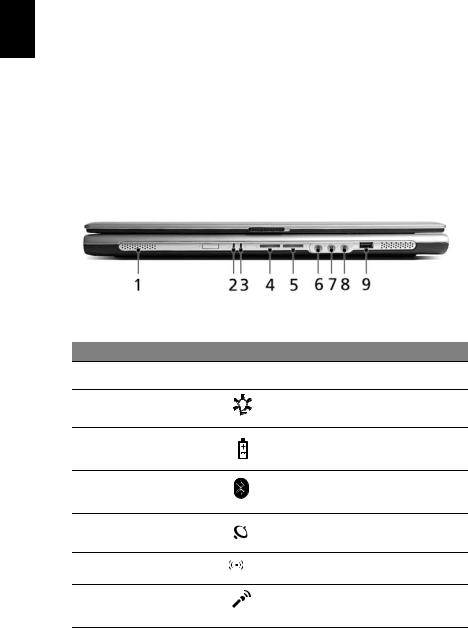
English
2
# |
Item |
Description |
5 |
Click buttons |
The left and right buttons function like the left and right mouse |
|
(Left, center and |
buttons; the center button serves as a 4-way scroll button. |
|
right) |
|
|
|
|
6 |
Touchpad |
Touch-sensitive pointing device which functions like a computer |
|
|
mouse. |
|
|
|
7 |
Status indicators |
Light-Emitting Diodes (LEDs) that turn on and off to show the |
|
|
status of the computer’s functions and components. |
|
|
|
8 |
Launch keys |
Buttons for launching frequently used programs. See “Launch |
|
|
keys” on page 14 for more details. |
|
|
|
9 |
Power button |
Turns the computer on and off. |
|
|
|
Closed front view
# |
Item |
Description |
1 |
Speakers |
Left and right speakers deliver stereo audio |
|
|
output. |
2 |
Power indicator |
Lights up when the computer is on. |
3 |
Battery indicator |
Lights up when the battery is being charged. |
4 |
Bluetooth communication |
Press to enable/disable the Bluetooth |
|
button/indicator (for |
function. Indicates the status of Bluetooth |
|
selected models) |
communication (optional). |
5 |
Wireless communication |
Press to enable/disable the wireless function. |
|
button/indicator |
Indicates the status of wireless LAN |
|
|
communication (optional). |
6 |
Line-in jack |
Accepts audio line-in devices (e.g., audio CD |
|
|
player, stereo walkman). |
7 |
Mic-in jack |
Accepts inputs from external microphones. |
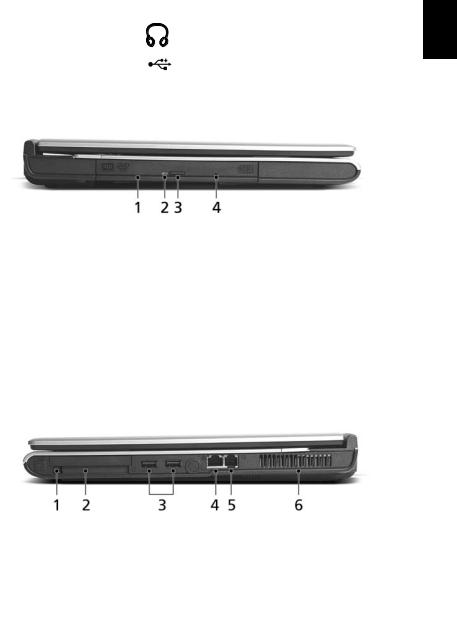
3
# |
Item |
Description |
8 |
Speaker/Line-Out/ |
Connects to audio line-out devices |
|
Headphone jack |
(e.g., speakers, headphones). |
|
|
|
9 |
USB 2.0 port |
Connects to Universal Serial Bus (USB) 2.0 |
|
|
devices (e.g., USB mouse, USB camera). |
|
|
|
Left view
# |
Item |
Description |
1 |
Optical drive |
Internal optical drive; accepts CDs or DVDs depending |
|
|
on the optical drive type. |
|
|
|
2 |
LED indicator |
Lights up when the optical drive is active. |
|
|
|
3 |
Emergency eject hole |
Ejects the optical drive tray when the computer is |
|
|
turned off |
|
|
|
4 |
Optical drive eject button |
Ejects the optical drive tray from the drive. |
|
|
|
Right view
English
# |
Item |
|
|
Description |
1 |
PC Card slot |
|
|
Ejects the PC Card from the slot. |
|
eject button |
|
|
|
|
|
|
|
|
2 |
PC Card slot |
|
|
Accepts one Type II CardBus PC Card. |
|
|
|
|
|
|
|
|
|
|
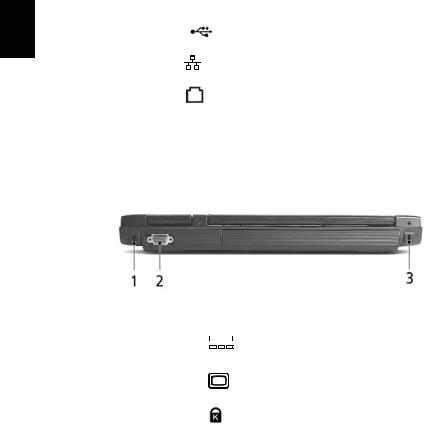
English
4
# |
Item |
Description |
3 |
Two USB 2.0 |
Connect to Universal Serial Bus (USB) 2.0 devices |
|
ports |
(e.g., USB mouse, USB camera). |
|
|
|
4 |
Network jack |
Connects to an Ethernet 10/100 based network. |
|
|
|
5 |
Modem jack |
Connects to a phone line. |
|
|
|
6 |
Ventilation slots |
Enable the computer to stay cool, even after |
|
|
prolonged use. |
|
|
|
Rear view
# |
Item |
|
|
|
|
|
Description |
|
|
|
|
|
|
|
|
1 |
Power jack |
|
|
|
|
|
Connects to an AC adaptor. |
|
|
|
|
|
|
|
|
|
|
|
|
|
|
|
|
2 |
External display port |
|
|
|
|
|
Connects to a display device (e.g., external |
|
|
|
|
|
|
|
monitor, LCD projector). |
|
|
|
|
|
|
|
|
3 |
Security keylock |
|
|
|
|
|
Connects to a Kensington-compatible computer |
|
|
|
|
|
|
|
security lock. |
|
|
|
|
|
|
|
|
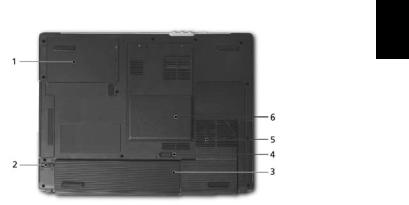
Base view
5
English
# |
Item |
Description |
|
|
|
1 |
Hard disk bay |
Houses the computer's hard disk (secured by a screw). |
|
|
|
2 |
Battery release |
Releases the battery for removal. |
|
latch |
|
|
|
|
3 |
Battery bay |
Houses the computer's battery pack. |
|
|
|
4 |
Battery lock |
Locks the battery in place. |
|
|
|
5 |
Cooling fan |
Helps keep the computer cool. |
|
|
Note: Do not cover or obstruct the opening of the fan. |
|
|
|
6 |
Memory |
Houses the computer's main memory. |
|
compartment |
|
|
|
|
